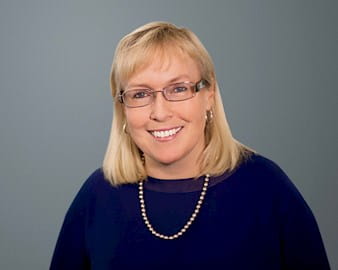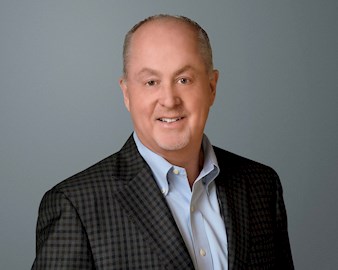
Two alumni CFOs share moments where they saw and seized opportunities for their companies to excel in difficult financial moments—from the adoption of the euro to the 2008 financial crisis.
- By
- May 09, 2019
- Finance

Jennifer Ceran, ’89, CFO of Smartsheet, Bellevue, Washington

The Challenge: When the European Union was preparing to adopt the euro in 1999, Jennifer Ceran, then director of treasury for Sara Lee’s European operations, saw an opportunity to create a global European cash-pool solution for all of Sara Lee’s more than 100 legal entities in this region. At the time, the company’s European country subsidiaries operated separate currency cash pools that were largely managed locally.
The Strategy: Ahead of euro adoption, Ceran wanted to learn how money moved through Europe and how this could change in the posteuro era, and in late 1997, she perceived banks weren’t yet planning for the transition. Ceran had already streamlined and modernized the banking activities and cash pool for the Netherlands’ banking structure, adding more than $1 million annually to the bottom line. She seized the debut of a new currency as her opportunity to modernize Sara Lee’s global European banking activities.
It wasn’t easy. Initial feedback from current and potential banking partners indicated that country-specific tax and legal restrictions would prevent consolidation. While her research showed those restrictions could be overcome, she knew she’d need to address cultural challenges to influence the local divisions’ CFOs to relinquish their local banking relationships and move to a centralized system.
I wanted to protect the bank, which had worked so hard to build this for us.
To find a banking partner, Ceran presented her vision to 300 bankers at a conference. She would only select one. To banks that sent in requests for proposals, she offered her ideas and data so they could build their own solution to serve their customers. With her banking partner, Ceran and the project team created from scratch one of the first European cash pools that would optimize cash in real time across the legal entities now part of the euro. As a team, Ceran and the bankers met with the individual CFOs to describe the new structure and address their concerns. Eighteen months later, a month after the euro debuted, in February 1999, the plan went live. During implementation, the team found a glitch, in which the intercompany flows were not reporting correctly. It took a week and a half for the team to identify and fix the issue.
“I did not let the local subsidiaries know that it was a set-up issue on the bank’s side. I told them it was something that I had missed. I wanted to protect the bank, which had worked so hard to build this for us,” she said. The company generated more than $2 million in bottom-line benefits through incremental interest income and reduced overdrafts annually with the modernization. The team also won Gold in the Cash Management category of the Alexander Hamilton Awards from Treasury & Risk magazine the next year.
The Takeaway: Don’t be afraid to approach a redesign from a clean slate. When it comes to challenging problems that require fundamental change in legacy rules and structures, take advantage of an upcoming catalyst that will enable you to break down old ways and implement much newer and better ones.
Tyler Rose, ’86, Executive Vice President and CFO of Kilroy Realty, Los Angeles

The Challenge: A significant cause of the 2008–09 global financial crisis was the overheating of real estate, and areas such as California were particularly devastated when the bubble burst. How does a real estate business not only survive but thrive during market turmoil?
The Strategy: Kilroy Realty had a 70-year-plus history, so executives had experience with different market cycles, and they wanted to take advantage of lower real estate prices. Tyler Rose, Kilroy Realty’s executive vice president and CFO, was a key member of the management team that was tasked with ensuring the firm had the capital to acquire new assets, especially since the debt markets were still shaky and not lending. The firm’s balance sheet going into the crisis was “pretty strong,” relatively speaking, he said, as the company was fiscally conservative prior to the recession. In addition, the team spent a considerable amount of time cultivating relationships with large unsecured lenders.
Rose wanted to further improve their financials by seeking an investment-grade rating. To reach that goal, the company raised equity in early 2010. “It was painful in terms of the stock price, but we were willing to raise equity to strengthen the balance sheet, position us to be an acquirer, and get investment-grade rated,” he said. It was important to tell Kilroy Realty’s story and explain its business plan for growth to both investors and the ratings agencies.
It was a nice, positive spiral upward. We were growing our asset value and lowering the cost of capital.
That first capital round allowed them to buy properties in ultradesirable areas such as San Francisco and greater Seattle in 2010, when other real estate firms weren’t in the market. They received an investment-grade rating later in 2010, which gave them the opportunity to further raise capital while lowering their cost of debt. “It was a nice, positive spiral upward. We were growing our asset value and lowering the cost of capital,” he said. Kilroy Realty more than tripled its value during this time, to a $10 billion company now, from $3 billion in 2009.
The Takeaway: Having a strong balance sheet and access to different types of capital, whether through equity, joint ventures, preferred stock, bank loans, or other forms is important to maintain liquidity. Some types of capital are easier to tap than others, depending on market conditions, and having diverse sources of capital is necessary to take advantage of opportunities.

Sailing provides Elise Sivilay, ’12 (EXP-17), with lessons about leadership, delegation, and mental focus.
Leadership Lessons from Sailing
With a new alumni club and a growing network, Booth graduates are making their mark on a continent full of possibilities.
Booth Alumni Are Changing the Game in Africa
Chicago’s cultural institutions have educated generations of visitors. Meet the alumnae charged with ensuring their financial health.
The Alumnae Safeguarding Chicago's Beloved Museums